gas type Lexus GS350 2016 Owner's Manual
[x] Cancel search | Manufacturer: LEXUS, Model Year: 2016, Model line: GS350, Model: Lexus GS350 2016Pages: 624, PDF Size: 15.29 MB
Page 48 of 624

481-1. For safe use
GS350_200t_GS F_OM_OM30E86U_(U)
■If the SRS airbags deploy (inflate)
●Slight abrasions, burns, bruising etc., may be sustained from SRS airbags, due to the
extremely high speed deployment (inflation) by hot gases.
●A loud noise and white powder will be emitted.
●Parts of the airbag module (steering wheel hub, airbag cover and inflator) as well as the
seats, the glove box, parts of the front and re ar pillars, and roof side rails may be hot for
several minutes. The airbag itself may also be hot.
●The windshield may crack.
●For Lexus Enform Safety Connect subscribers, if the SRS airbags deploy or in the event
of a severe rear-end collision, the system is designed to send an emergency call to the
response center, notifying them of the vehicl e’s location (without needing to push the
“SOS” button) and an agent will attempt to speak with the occupants to ascertain the
level of emergency and assistance required . If the occupants are unable to communi-
cate, the agent automatically treats the call as an emergency and helps to dispatch the
necessary emergency services. ( P. 3 7 2 )
■SRS airbag deployment conditions (SRS front airbags)
●The SRS front airbags will deploy in the event of an impact that exceeds the set thresh-
old level (the level of force correspondin g to an approximately 12 - 18 mph [20 -
30 km/h] frontal collision with a fixed wall that does not move or deform).
However, this threshold velocity will be considerably higher in the following situations:
• If the vehicle strikes an object, such as a parked vehicle or sign pole, which can move or deform on impact
• If the vehicle is involved in an underride collision, such as a collision in which the
front of the vehicle “underrides”, or goes under, the bed of a truck
●Depending on the type of collision, it is possib le that only the seat belt pretensioners will
activate.
●The SRS front airbags for the front passenger will not activate if there is no passenger
sitting in the front passenger seat. However, the SRS front airbags for the front passen-
ger may deploy if luggage is put in the seat, even if the se at is unoccupied. (P. 5 2 )
■SRS airbag deployment conditions (S RS side and curtain shield airbags)
●The SRS side and curtain shield airbags wi ll deploy in the event of an impact that
exceeds the set threshol d level (the level of force corresponding to the impact force
produced by an approximately 3300 lb. [1500 kg] vehicle colliding with the vehicle
cabin from a direction perpendicular to the vehicle orientation at an approximate
speed of 12 - 18 mph [20 - 30 km/h]).
●The SRS curtain shield airbags will deploy in the event of vehicle rollover.
●The SRS side and curtain shield airbags may al so deploy in the event of a severe frontal
collision.
Page 227 of 624
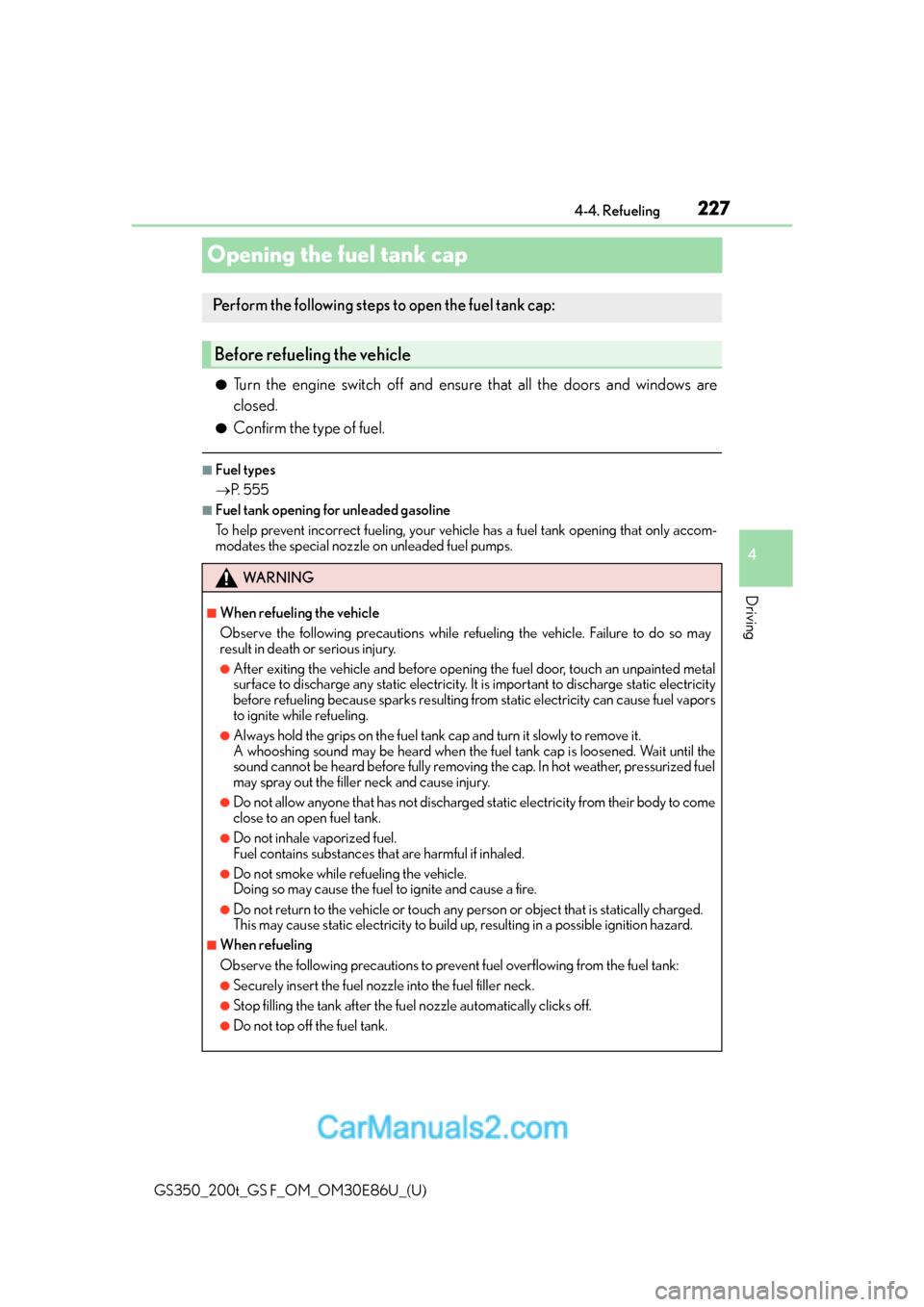
227
GS350_200t_GS F_OM_OM30E86U_(U)4-4. Refueling
4
Driving
Opening the fuel tank cap
●Turn the engine switch off and ensure that all the doors and windows are
closed.
●Confirm the type of fuel.
■Fuel types
P. 555
■Fuel tank opening for unleaded gasoline
To help prevent incorrect fueling, your vehicle has a fuel tank opening that only accom-
modates the special nozzle on unleaded fuel pumps.
Perform the following steps to open the fuel tank cap:
Before refueling the vehicle
WA R N I N G
■When refueling the vehicle
Observe the following precautions while refu eling the vehicle. Failure to do so may
result in death or serious injury.
●After exiting the vehicle and before openin g the fuel door, touch an unpainted metal
surface to discharge any static electricity. It is important to discharge static electricity
before refueling because sparks resulting fr om static electricity can cause fuel vapors
to ignite while refueling.
●Always hold the grips on th e fuel tank cap and turn it slowly to remove it.
A whooshing sound may be heard when the fuel tank cap is loosened. Wait until the
sound cannot be heard before fully removing the cap. In hot weather, pressurized fuel
may spray out the filler neck and cause injury.
●Do not allow anyone that has not discharged static electricity from their body to come
close to an open fuel tank.
●Do not inhale vaporized fuel.
Fuel contains substances th at are harmful if inhaled.
●Do not smoke while refueling the vehicle.
Doing so may cause the fuel to ignite and cause a fire.
●Do not return to the vehicle or touch any person or object that is statically charged.
This may cause static electricity to build up, resulting in a possible ignition hazard.
■When refueling
Observe the following precautions to prevent fuel overflowing from the fuel tank:
●Securely insert the fuel nozzle into the fuel filler neck.
●Stop filling the tank after the fuel nozzle automatically clicks off.
●Do not top off the fuel tank.
Page 384 of 624
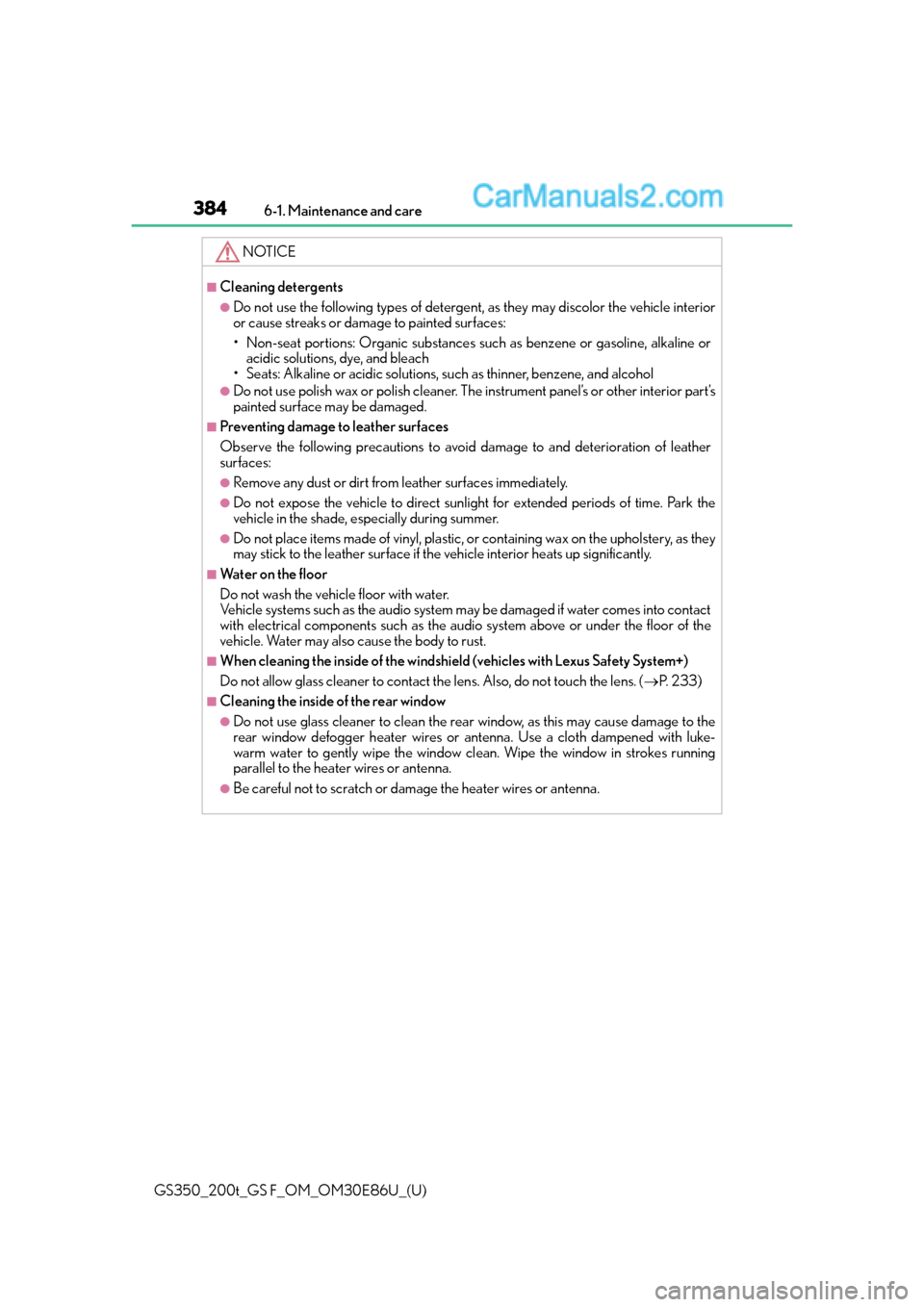
384
GS350_200t_GS F_OM_OM30E86U_(U)6-1. Maintenance and care
NOTICE
■Cleaning detergents
●Do not use the following types of detergent, as they may discolor the vehicle interior
or cause streaks or damage to painted surfaces:
• Non-seat portions: Organic substances su
ch as benzene or gasoline, alkaline or
acidic solutions, dye, and bleach
• Seats: Alkaline or acidic solutions, such as thinner, benzene, and alcohol
●Do not use polish wax or polish cleaner. The instrument panel’s or other interior part’s
painted surface may be damaged.
■Preventing damage to leather surfaces
Observe the following precautions to avoid damage to and deterioration of leather
surfaces:
●Remove any dust or dirt from leather surfaces immediately.
●Do not expose the vehicle to direct sunlight for extended periods of time. Park the
vehicle in the shade, especially during summer.
●Do not place items made of vinyl, plastic, or containing wax on the upholstery, as they
may stick to the leather su rface if the vehicle interior heats up significantly.
■Water on the floor
Do not wash the vehicle floor with water.
Vehicle systems such as the audio system may be damaged if water comes into contact
with electrical components such as the au dio system above or under the floor of the
vehicle. Water may also cause the body to rust.
■When cleaning the inside of the windshie ld (vehicles with Lexus Safety System+)
Do not allow glass cleaner to contact the lens. Also, do not touch the lens. ( P. 2 3 3 )
■Cleaning the inside of the rear window
●Do not use glass cleaner to clean the rear window, as this may cause damage to the
rear window defogger heater wires or antenna. Use a cloth dampened with luke-
warm water to gently wipe the window cl ean. Wipe the window in strokes running
parallel to the heater wires or antenna.
●Be careful not to scratch or damage the heater wires or antenna.
Page 541 of 624
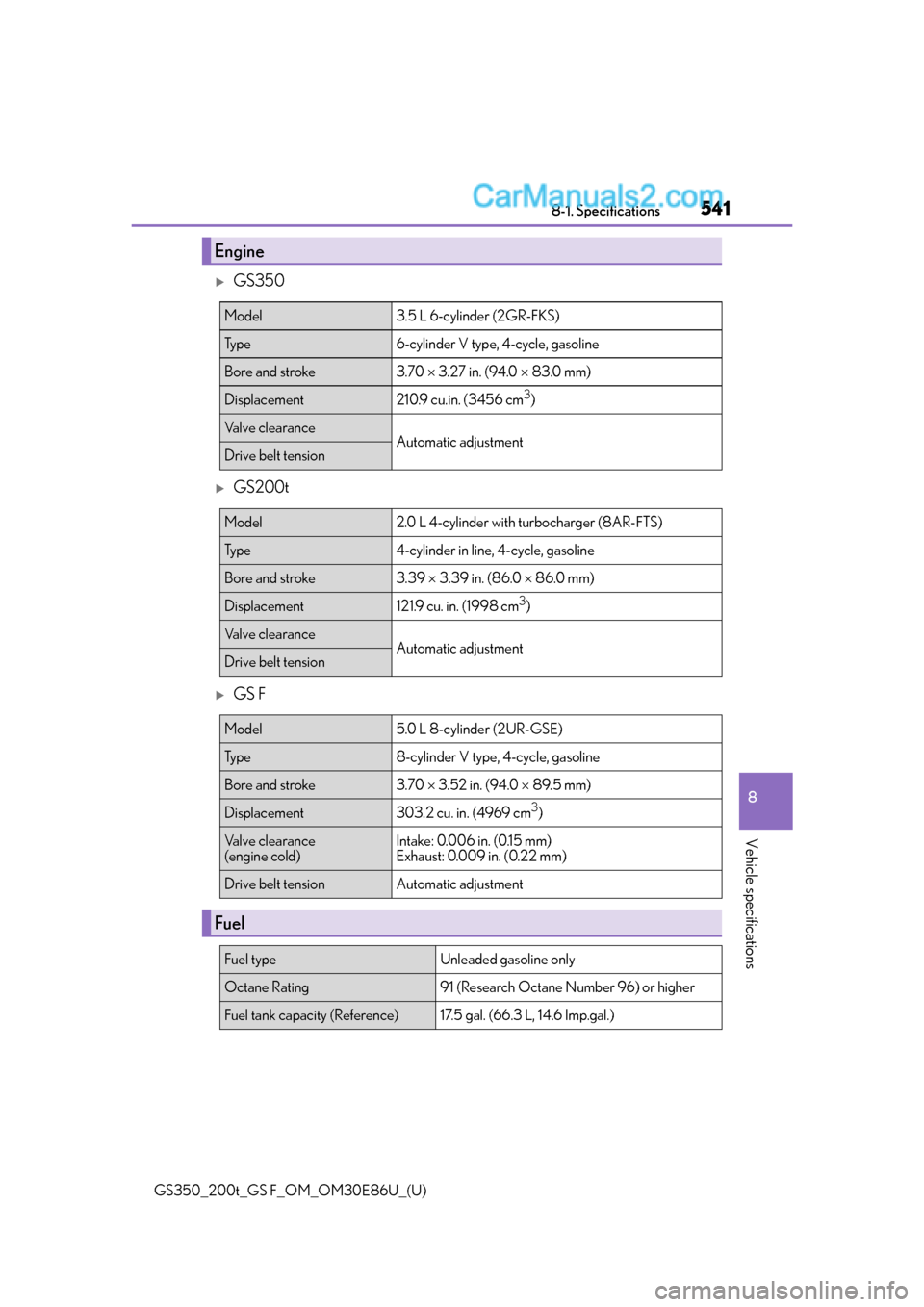
GS350_200t_GS F_OM_OM30E86U_(U)
5418-1. Specifications
8
Vehicle specifications
GS350
GS200t
GS F
Engine
Model3.5 L 6-cylinder (2GR-FKS)
Ty p e6-cylinder V type, 4-cycle, gasoline
Bore and stroke3.70 3.27 in. (94.0 83.0 mm)
Displacement210.9 cu.in. (3456 cm3)
Valve clearanceAutomatic adjustmentDrive belt tension
Model2.0 L 4-cylinder with turbocharger (8AR-FTS)
Ty p e4-cylinder in line, 4-cycle, gasoline
Bore and stroke3.39 3.39 in. (86.0 86.0 mm)
Displacement121.9 cu. in. (1998 cm3)
Valve clearanceAutomatic adjustmentDrive belt tension
Model5.0 L 8-cylinder (2UR-GSE)
Ty p e8-cylinder V type, 4-cycle, gasoline
Bore and stroke3.70 3.52 in. (94.0 89.5 mm)
Displacement303.2 cu. in. (4969 cm3)
Valve clearance
(engine cold)Intake: 0.006 in. (0.15 mm)
Exhaust: 0.009 in. (0.22 mm)
Drive belt tensionAutomatic adjustment
Fuel
Fuel typeUnleaded gasoline only
Octane Rating91 (Research Octane Number 96) or higher
Fuel tank capacity (Reference)17.5 gal. (66.3 L, 14.6 Imp.gal.)
Page 557 of 624
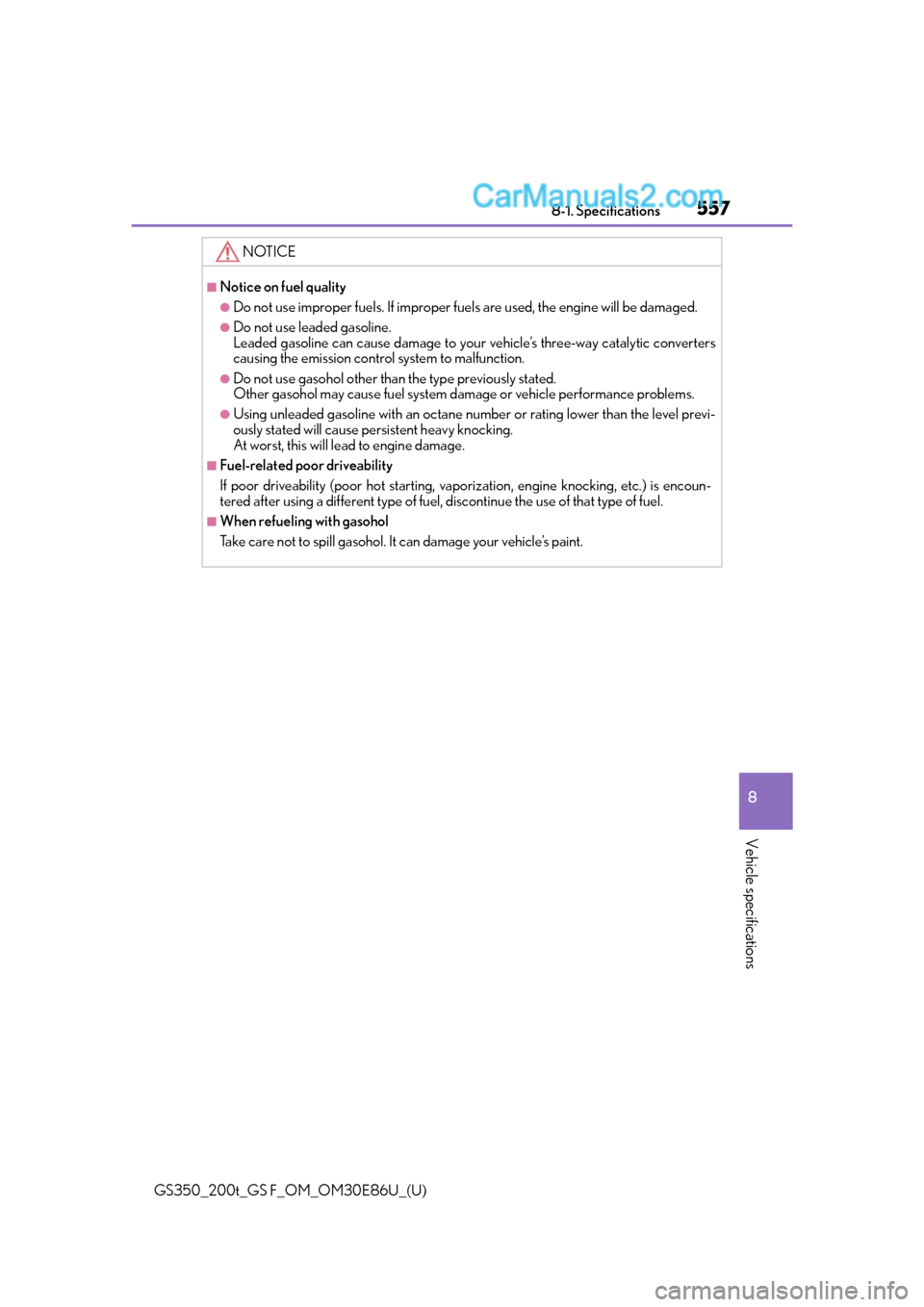
GS350_200t_GS F_OM_OM30E86U_(U)
5578-1. Specifications
8
Vehicle specifications
NOTICE
■Notice on fuel quality
●Do not use improper fuels. If improper fuels are used, the engine will be damaged.
●Do not use leaded gasoline.
Leaded gasoline can cause damage to your vehicle’s three-way catalytic converters
causing the emission control system to malfunction.
●Do not use gasohol other than the type previously stated.
Other gasohol may cause fuel system damage or vehicle performance problems.
●Using unleaded gasoline with an octane number or rating lower than the level previ-
ously stated will cause persistent heavy knocking.
At worst, this will lead to engine damage.
■Fuel-related poor driveability
If poor driveability (poor hot starting, vaporization, engine knocking, etc.) is encoun-
tered after using a different type of fuel, discontinue the use of that type of fuel.
■When refueling with gasohol
Take care not to spill gasohol. It can damage your vehicle’s paint.
Page 624 of 624
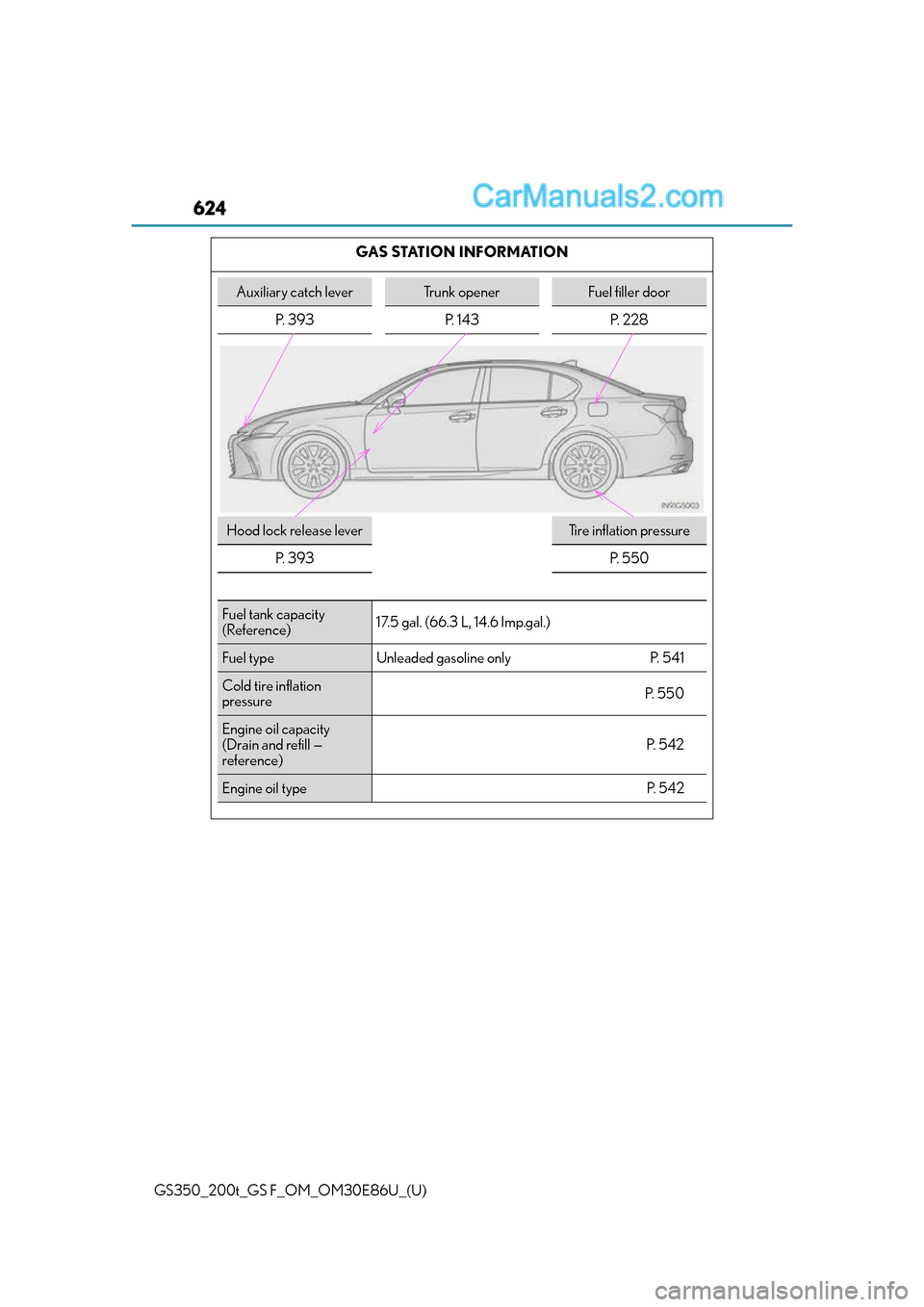
624
GS350_200t_GS F_OM_OM30E86U_(U)GAS STATION INFORMATION
Auxiliary catch leverTrunk openerFuel filler door
P. 393P. 143P. 228
Hood lock release leverTire inflation pressure
P. 3 9 3
P. 5 5 0
Fuel tank capacity
(Reference) 17.5 gal. (66.3 L, 14.6 Imp.gal.)
Fuel type
Unleaded gasoline only P. 541
Cold tire inflation
pressure P. 5 5 0
Engine oil capacity
(Drain and refill —
reference) P. 5 4 2
Engine oil type
P. 542